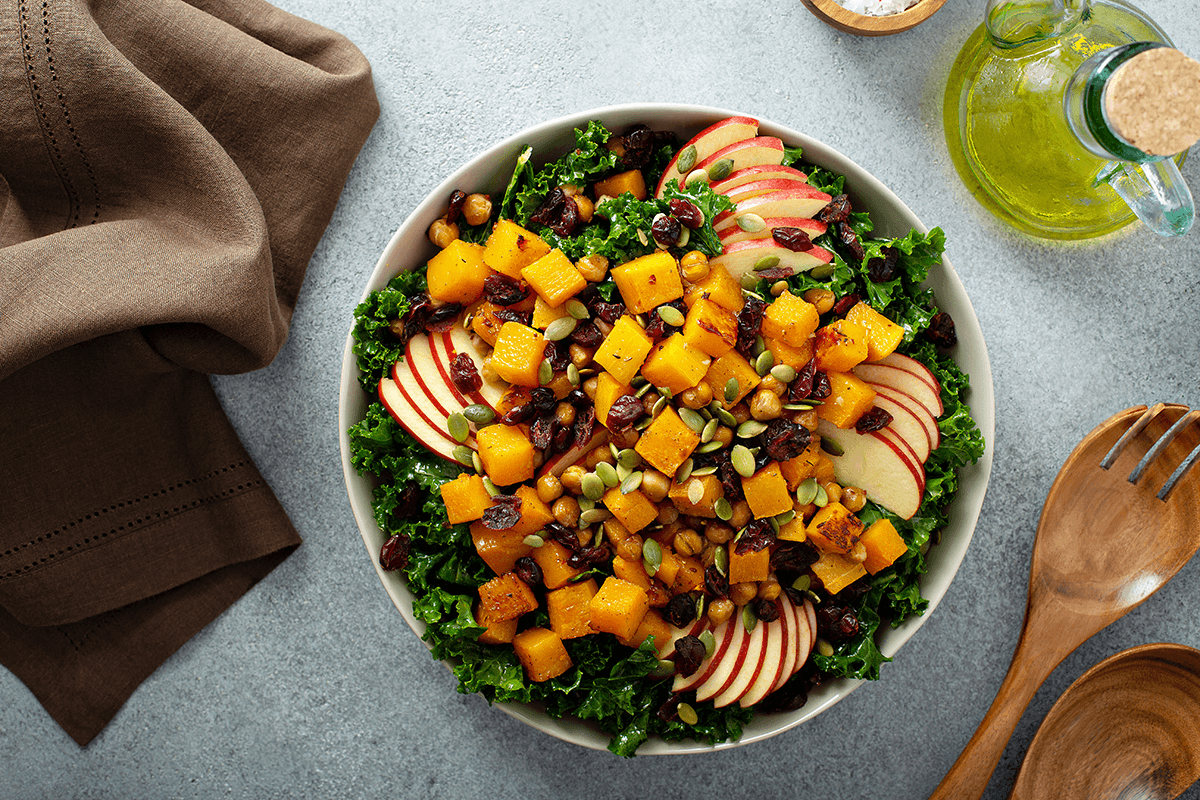Fall for colorful produce this season

The fall brings an abundance of nutritious fruits and vegetables. People tend to eat more produce this time of year because the season offers flavorful foods that are popular for fall-inspired dishes.
“The more colorful the food, the more nutritionally dense it is,” said Dr. Luis Rustveld, registered dietitian and associate professor of family and community medicine at Baylor College of Medicine. “Try to get produce in-season because it will be more nutrient-dense. You also support local farmers by buying locally produced, in-season items, rather than products shipped from a thousand miles away.”
Pumpkin/squash
Like most fall produce, pumpkin and squash are rich in vitamins A and C, fiber and antioxidants, which help boost immune function and support digestion. While fresh pumpkin requires a bit of effort, it can be used in a variety of dishes. Scoop out the seeds and roast it in the oven or on the grill for a tasty snack. The pumpkin usually caramelizes and develops a natural sweetness, but you can add some brown sugar, marshmallows or dried cranberries to it for a sweet treat. Using spices like cinnamon or nutmeg without added sugars provides flavor without extra calories. You can also peel the pumpkin, scoop out the seeds and blend it to use in lattes, pies or other desserts.
“Pumpkin takes some elbow grease and a sharp knife to prepare. However, you can use canned pumpkin – sweetened or unsweetened. I suggest using unsweetened to control the amount of sugar and calories,” Rustveld said.
When choosing pumpkin, squash or root vegetables, look for firm produce without soft spots. Softness may indicate it has been sitting out for too long or is bruised.
Apples
Apples are rich in vitamins and minerals and high in fiber. They can be enjoyed fresh or incorporated into different recipes, such as apple pie or caramel apples. Applesauce is a popular ingredient used in desserts to add sweetness and as a healthier fat substitute in baking. Fall brings a variety of delicious apples like Red Delicious, Braeburn and Honeycrisp.
Cranberries
Cranberries are high in potassium and vitamins A and C. The tart fruit requires some preparation, such as blanching or steaming to reduce the bitterness. Adding sugar can help balance the tartness. You can also create cranberry sauces or fillings using an artificial sweetener to reduce the sugar content.
Frozen cranberries are available year-round and come in cans or containers as well as a congealed paste for pies and desserts. Rustveld recommends limiting dried cranberries unless used sparingly in oatmeal or salads.
Cabbage
Cabbage, which is high in antioxidants, fiber and vitamins A and C, can be enjoyed raw or cooked. If raw cabbage is too hard, microwaving it can soften it for a salad. Cabbage is also commonly found in soups and stews.
“Cabbage is heart healthy and works well in salads or pairs with recipes like meatloaf or mashed potatoes,” he said.
Beets
Beets are high in iron, antioxidants and nutrients like folate. They can be steamed and added to salads or stews. They are also a popular ingredient in juices and smoothies. While beets are available canned or jarred, it’s better to limit canned beets, as they can be high in sodium. Rustveld recommends fresh or jarred beets with less sodium.
“Beets are easier to prepare than pumpkin due to their smaller size, and they’re more manageable for everyday dishes,” he said.
Pomegranate
Pomegranate is high in antioxidants, fiber and vitamin C, and is lower in sugar compared to some other fruits. It is a nutritious, low-calorie option.
Kale
Kale, a nutrient-dense leafy green vegetable, is rich in potassium, fiber and vitamins A, C and K. Kale is a popular ingredient for salads, stews and smoothies.
How much is too much?
People are more likely to get hypervitaminosis, particularly for fat-soluble vitamins (A, D, E and K), from overuse of supplements rather than food. Those who consume a high intake of fortified foods and supplements in combination could be at risk.
“Your body is designed to get nutrients from food, so it’s unlikely you’ll develop hypervitaminosis from food alone. It’s more likely to occur from taking excessive amounts of supplements in addition to a diet,” Rustveld said.
Those with kidney disease should monitor their potassium (like bananas, oranges and leafy greens) and vitamin K intake as high levels can cause complications. Individuals on anti-clotting medications should also limit vitamin K intake as it affects blood clotting.
For people with diarrhea, reducing fiber intake can help the intestines heal. Soluble fiber (such as from oats or bananas) is gentler on the gut than insoluble fiber (such as from bran or raw vegetables).
Overall benefits
Bright-colored produce is rich in antioxidants, which help reduce inflammation – a major contributor to chronic conditions such as diabetes, obesity and arthritis. Consuming antioxidant-rich fruits and vegetables can improve overall health.
Foods higher in fiber help regulate blood sugar, making them beneficial for people with diabetes or prediabetes. Adding fiber to the diet can also lower LDL (bad) cholesterol levels.
“Fall produce is high in vitamins A and C, fiber, iron, minerals and antioxidants that promote heart and gut health, keeping you regular and supporting your overall well-being,” Rustveld said.
By Homa Warren



